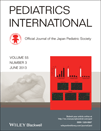Severely high serum unbound bilirubin level after abdominal surgery in a newborn
Corresponding Author
Ichiro Morioka
Department of Pediatrics, Kobe University Hospital, Kobe, Japan
Correspondence: Ichiro Morioka, MD PhD, Department of Pediatrics, Kobe University Hospital, 7-5-2, Kusunoki-cho, Chuo-ku, Kobe 650-0017, Japan. E-mail: [email protected]Search for more papers by this authorAkihiro Miwa
Department of Pediatrics, Kobe University Hospital, Kobe, Japan
Search for more papers by this authorTomoyuki Yokota
Department of Pediatrics, Kobe University Hospital, Kobe, Japan
Search for more papers by this authorChuong Thieu Do Huu
Department of Pediatrics, Kobe University Hospital, Kobe, Japan
Search for more papers by this authorMiwako Nagasaka
Department of Pediatrics, Kobe University Hospital, Kobe, Japan
Search for more papers by this authorTsubasa Koda
Department of Pediatrics, Kobe University Hospital, Kobe, Japan
Search for more papers by this authorKiyomi Matsuo
Department of Pediatrics, Kobe University Hospital, Kobe, Japan
Search for more papers by this authorSatoru Morikawa
Department of Pediatrics, Kobe University Hospital, Kobe, Japan
Department of Community Medicine and Social Healthcare Science, Kobe University Graduate School of Medicine, Kobe, Japan
Search for more papers by this authorAkio Shibata
Department of Pediatrics, Kobe University Hospital, Kobe, Japan
Search for more papers by this authorChieko Hisamatsu
Division of Pediatric Surgery, Department of Surgery, Kobe University Hospital, Kobe, Japan
Search for more papers by this authorHisahide Nishio
Department of Pediatrics, Kobe University Hospital, Kobe, Japan
Department of Community Medicine and Social Healthcare Science, Kobe University Graduate School of Medicine, Kobe, Japan
Search for more papers by this authorHideto Yamada
Department of Obstetrics and Gynecology, Kobe University Hospital, Kobe, Japan
Search for more papers by this authorEiji Nishijima
Division of Pediatric Surgery, Department of Surgery, Kobe University Hospital, Kobe, Japan
Search for more papers by this authorKazumoto Iijima
Department of Pediatrics, Kobe University Hospital, Kobe, Japan
Search for more papers by this authorCorresponding Author
Ichiro Morioka
Department of Pediatrics, Kobe University Hospital, Kobe, Japan
Correspondence: Ichiro Morioka, MD PhD, Department of Pediatrics, Kobe University Hospital, 7-5-2, Kusunoki-cho, Chuo-ku, Kobe 650-0017, Japan. E-mail: [email protected]Search for more papers by this authorAkihiro Miwa
Department of Pediatrics, Kobe University Hospital, Kobe, Japan
Search for more papers by this authorTomoyuki Yokota
Department of Pediatrics, Kobe University Hospital, Kobe, Japan
Search for more papers by this authorChuong Thieu Do Huu
Department of Pediatrics, Kobe University Hospital, Kobe, Japan
Search for more papers by this authorMiwako Nagasaka
Department of Pediatrics, Kobe University Hospital, Kobe, Japan
Search for more papers by this authorTsubasa Koda
Department of Pediatrics, Kobe University Hospital, Kobe, Japan
Search for more papers by this authorKiyomi Matsuo
Department of Pediatrics, Kobe University Hospital, Kobe, Japan
Search for more papers by this authorSatoru Morikawa
Department of Pediatrics, Kobe University Hospital, Kobe, Japan
Department of Community Medicine and Social Healthcare Science, Kobe University Graduate School of Medicine, Kobe, Japan
Search for more papers by this authorAkio Shibata
Department of Pediatrics, Kobe University Hospital, Kobe, Japan
Search for more papers by this authorChieko Hisamatsu
Division of Pediatric Surgery, Department of Surgery, Kobe University Hospital, Kobe, Japan
Search for more papers by this authorHisahide Nishio
Department of Pediatrics, Kobe University Hospital, Kobe, Japan
Department of Community Medicine and Social Healthcare Science, Kobe University Graduate School of Medicine, Kobe, Japan
Search for more papers by this authorHideto Yamada
Department of Obstetrics and Gynecology, Kobe University Hospital, Kobe, Japan
Search for more papers by this authorEiji Nishijima
Division of Pediatric Surgery, Department of Surgery, Kobe University Hospital, Kobe, Japan
Search for more papers by this authorKazumoto Iijima
Department of Pediatrics, Kobe University Hospital, Kobe, Japan
Search for more papers by this authorAbstract
We report a newborn with intestinal malrotation who developed a severely high serum unbound bilirubin level and a low serum albumin level without a marked increase in serum total bilirubin level after abdominal surgery, which required exchange transfusion and albumin supplementation. The serum unbound bilirubin level may be highly relative to the serum total bilirubin level in newborns who have undergone abdominal surgery soon after birth and are hypoalbuminemic after surgery.
References
- 1 Nakamura H, Yonetani M, Uetani Y, Funato M, Lee Y. Determination of serum unbound bilirubin for prediction of kernicterus in low birthweight infants. Acta Paediatr. Jpn. 1992; 34: 642–647.
- 2 Funato M, Tamai H, Shimada S, Nakamura H. Vigintiphobia, unbound bilirubin, and auditory brainstem responses. Pediatrics 1994; 93: 50–53.
- 3
Madan A, MacMahon JR, Stevenson DK. Neonatal hyperbilirubinemia. In: HW Taeusch, RA Ballard et al. (eds). Avery's Diseases of the Newborn 8th Ed. Elsevier Saunders, Philadelphia, PA, 2005; 1226–1256.
10.1016/B978-072169347-7.50081-0 Google Scholar
- 4 Yamauchi Y. Transcutaneous bilirubinometer and measurement of unbound bilirubin. Perinat. Med. 2007; 37: 1247–1252 (in Japanese).
- 5 Yuan XY, Zhang CH, He YL et al. Is albumin administration beneficial in early stage of postoperative hypoalbuminemia following gastrointestinal surgery?: a prospective randomized controlled trial. Am. J. Surg. 2008; 196: 751–755.
- 6 Miwa A, Morioka I, Hisamatsu C et al. Hypoalbuminemia following abdominal surgery leads to high serum unbound bilirubin concentrations in newborns soon after birth. Neonatology 2011; 99: 202–207.
- 7 Funato M. Pathogenesis and treatment of hemolytic disease of the newborn. Jpn J. Transfus. Med. 2002; 47: 837–844 (in Japanese).
- 8 Pediatrics, Kobe University School of Medicine. [ Management of Premature and Mature Newborns]. Nihon Syoni Iji Syuppan, Tokyo, 2000; 225–240 (in Japanese).
- 9 Okada H, Kusaka T, Koyano K et al. Influence of bilirubin photoisomers on unbound bilirubin measurement in the clinical settings. Ann. Clin. Biochem. 2012; 49: 795–799.
- 10 Lee YK, Daito Y, Katayama Y, Minami H, Negishi H. The significance of measurement of serum unbound bilirubin concentrations in high-risk infants. Pediatrics 2009; 51: 595–599.
- 11 Cashore WJ, Horwich A, Karotkin EH, Oh W. Influence of gestational age and clinical status on bilirubin-binding capacity in newborn infants. Sephadex G- 25 gel filtration technique. Am. J. Dis. Child. 1977; 131: 898–901.
- 12 American Academy of Pediatrics. Management of hyperbilirubinemia in the newborn infant 35 or more weeks of gestation. Pediatrics 2004; 114: 297–316.




